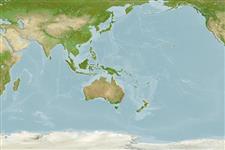Environment: milieu / climate zone / depth range / distribution range
Écologie
marin démersal; profondeur 0 - 10 m (Ref. 9002). Subtropical
Southwest Pacific: southeastern Australia only.
Taille / Poids / Âge
Maturity: Lm ? range ? - ? cm
Max length : 45.0 cm SL mâle / non sexé; (Ref. 33616)
Épines dorsales (Total): 17; Rayons mous dorsaux (Total): 18-20; Épines anales 3; Rayons mous anaux: 6 - 7; Vertèbres: 35. Adults have a short-based anal fin, pectoral fins with thickened lower rays, and are grey to blue-black with lighter mottling on the sides and light spots on the fins (Ref. 33616). It is distinguished from its congeners in having larger body scales (lateral-line scales 72± 82 vs. 83± 120) and absence of vomerine teeth (Ref. 86913).
Found on shallow exposed rocky shores, aggregating in high-energy zone, just below foaming surface to depths of about 10 m (Ref. 9002); in kelp and weed areas (Ref. 86913). Feed on either loose or attached weeds and algae (Ref. 9002); mainly consisting of Corallina pilulifera,
together with smaller quantities of Ulva actuca, Jania and filamentous species such
as Sphacelaria sp. (Ref. 86913).
Life cycle and mating behavior
Maturité | Reproduction | Frai | Œufs | Fécondité | Larves
Russell, B.C., 2000. Review of the southern temperate fish family Aplodactylidae (Pisces: Perciformes). J. Nat. Hist. 34(1):2157-2171. (Ref. 86913)
Statut dans la liste rouge de l'IUCN (Ref. 130435)
Menace pour l'homme
Harmless
Utilisations par l'homme
Plus d'informations
Noms communsSynonymesMétabolismePrédateursÉcotoxicologieReproductionMaturitéFraiRassemblement de ponteFéconditéŒufsDéveloppement de l'œuf
RéférencesAquacultureProfil d'aquacultureSouchesGénétiqueElectrophoresesHéritabilitéPathologiesTraitementNutrientsMass conversion
CollaborateursImagesStamps, Coins Misc.SonsCiguateraVitesseType de nageSurface branchialeOtolithesCerveauxVision
Outils
Articles particuliers
Télécharger en XML
Sources Internet
Estimates based on models
Preferred temperature (Ref.
123201): 17.6 - 27.5, mean 25.5 °C (based on 400 cells).
Phylogenetic diversity index (Ref.
82804): PD
50 = 0.5625 [Uniqueness, from 0.5 = low to 2.0 = high].
Bayesian length-weight: a=0.00468 (0.00190 - 0.01153), b=3.14 (2.92 - 3.36), in cm total length, based on LWR estimates for this (Sub)family-body shape (Ref.
93245).
Niveau trophique (Ref.
69278): 2.0 ±0.00 se; based on food items.
Fishing Vulnerability (Ref.
59153): Moderate vulnerability (42 of 100).
Nutrients (Ref.
124155): Calcium = 126 [61, 271] mg/100g; Iron = 1.28 [0.74, 2.46] mg/100g; Protein = 18.1 [17.0, 19.2] %; Omega3 = 0.147 [0.074, 0.292] g/100g; Selenium = 25.7 [11.8, 62.1] μg/100g; VitaminA = 6.8 [1.6, 28.5] μg/100g; Zinc = 1.28 [0.85, 1.93] mg/100g (wet weight);
